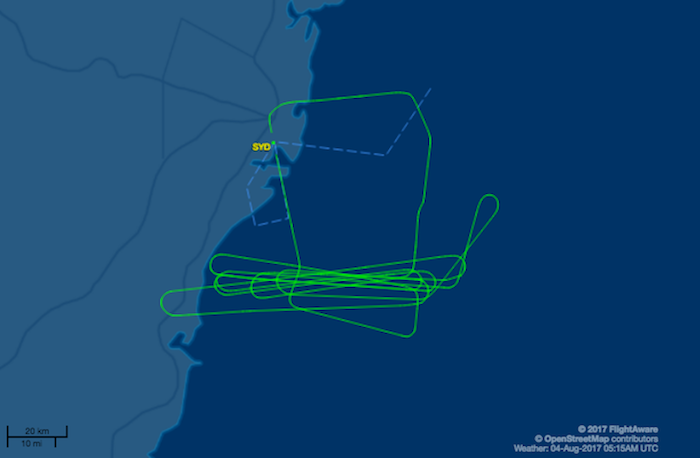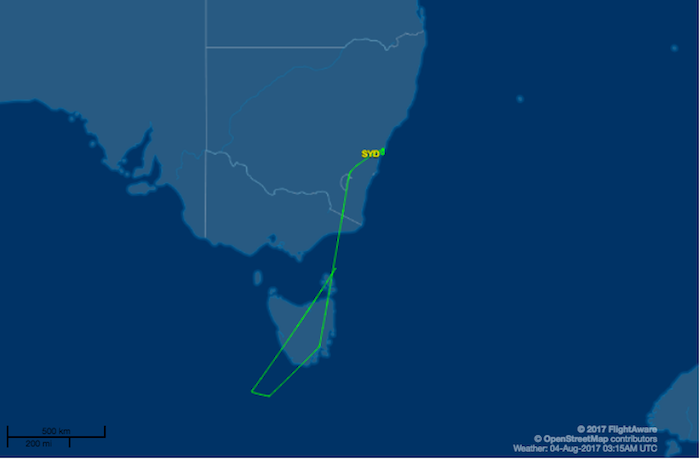One of the reasons aviation is so safe is because airlines always err on the side of caution (well, or at least they should). For every serious incident we hear about there are thousands of incidents that are non-stories.
There are all kinds of reasons that planes can return back to their origin airport, from a minor mechanical fault, to an engine light going off, to a medical emergency. The issue is that for many planes the maximum landing weight is significantly lower than the maximum takeoff weight, so unless it’s an absolute emergency, they often need to get rid of some fuel before landing. For small planes that just means flying in circles, while most heavy aircraft are able to “dump” fuel. While costly, it saves potentially spending many hours circling over a city.
There’s nothing dangerous about dumping fuel, so in and of itself that’s not a story.
However, Qantas had a very bad day in Sydney today (August 4, 2017), as two heavy aircraft had to return to Sydney around the same time, and both had to dump fuel. Here’s Qantas’ statement about the situation:
Qantas flight QF 7 from Sydney to Dallas landed safely and without incident at Sydney International Airport at 4:38pm AEST.
The flight returned to Sydney due to a mechanical issue.
The flaps on the aircraft (which are attached to the wing) are unable to retract which means the aircraft can’t fly efficiently.
As the Dallas flight is our longest on the network, the captain made the decision to return to Sydney.
The aircraft – an Airbus A380 – will be inspected by engineers.
A second flight, Qantas flight QF 63 from Sydney to Johannesburg also needed to return to Sydney due to a cracked pane of glass on the aircraft windscreen.
An aircraft windscreen is made up of three layers of glass, the outer pane had cracked but did not compromise the integrity of the aircraft.
The aircraft was safe to continue to Johannesburg but the captain made the decision to return as the windscreen will be replaced at Qantas’ engineering base in Sydney.
The aircraft – Boeing 747-400 landed safely and without incident.
Our operational teams are working through accommodating passengers or offering them transport home before replacement services are organized.
Qantas 7, the A380 bound for Dallas, spent 2hr40min in the air, and never actually flew anywhere. Instead it just circled around Sydney.

Meanwhile Qantas 63, bound for Johannesburg, spent 3hr54min in the air, and flew over 1,000 kilometers before it turned around.

I feel sorry for the ground staff who had to rebook these hundreds of passengers!
There’s a video of one of the planes dumping fuel, which is worth watching for the commentary alone. Clearly the guy filming has no clue what’s going on, because he’s convinced the plane is on fire, says that “it better not explode,” talks about how other planes are “rescue jets” (I’d love to see how that works in practice), and says that the plane is “going down.” Meanwhile what’s really happening is just a routine fuel dumping. 😉
Of course I’m happy that everyone was okay (not that there was really anything risky here), but what an unlucky day for Qantas. Between the amount of fuel they dumped ($$$$) and the passengers they had to accommodate and rebook, this is costly.





"In and itself" LOL. Well anyway and "irregardless" of what anyone postulates, jet fuel is most certainly a toxin in the air, vaporized or not, still coming into lungs.
oh no mate ! i think he's gonna do a huey !
Is there an award on YouTube for most stupid producer of any video ever award? I think the guy who supplied the above video would surely be one of the main contenders.
Good gracious, I live in London and if we thought that all planes dumping fuel were 'going down', the city would live almost constant in a state of panic. (Shaking head emoji if there is one)
I think your comments on the commentary in the video could have some further clarity. The major news story for the last week in Australia has been that of the imminent detection of an immediate plan to down a plane departing Sydney with a bomb hidden in a kitchen utensil (which did not get through airport security0 and a subsequent plan to down a jet departing Sydney using toxic gas. The very significant event has...
I think your comments on the commentary in the video could have some further clarity. The major news story for the last week in Australia has been that of the imminent detection of an immediate plan to down a plane departing Sydney with a bomb hidden in a kitchen utensil (which did not get through airport security0 and a subsequent plan to down a jet departing Sydney using toxic gas. The very significant event has thrown Australian Airports into terror status imminent levels and is gaining extreme levels of media attention. Given the media caused the filters reactions may seem more justified with context.
AFAIK Qantas is an acronym for Queensland And Northern Territory Aerial Services. So definitely no u.
@Dalo
Yep, that's how it works. You get to decide what a company is called...
And another thing : if I want Quantas to have a U then it will have a U .
In and of itself.... a mildly interesting report . Adam , don't make up your own rules . Don't be upset about things of absolutely no importance .
cost to fuel 747 @Tom and others
Cruising costs aprox. $13,380 per hour (Using Ashkay Burman's figures). This does not specify the type of 747 (747-400 vs 747-8i or 737-600 vs 737-900).
Or, as per http://science.howstuffworks.com/transport/flight/modern/question192.htm
"... a Boeing 747 uses approximately 1 gallon of fuel (about 4 liters) every second. Over the course of a 10-hour flight, it might burn 36,000 gallons (150,000 liters). According to Boeing's Web site, the 747 burns approximately 5...
cost to fuel 747 @Tom and others
Cruising costs aprox. $13,380 per hour (Using Ashkay Burman's figures). This does not specify the type of 747 (747-400 vs 747-8i or 737-600 vs 737-900).
Or, as per http://science.howstuffworks.com/transport/flight/modern/question192.htm
"... a Boeing 747 uses approximately 1 gallon of fuel (about 4 liters) every second. Over the course of a 10-hour flight, it might burn 36,000 gallons (150,000 liters). According to Boeing's Web site, the 747 burns approximately 5 gallons of fuel per mile (12 liters per kilometer)..."
@Tom and others
the cost to fuel A380, Qantas from SYD to LAX = around $244,539
http://www.opshots.net/2015/04/aircraft-operating-series-aircraft-operating-expenses/
Considering the website this is info is from, the sum I assume is in US dollars (?).
Confusing. The article says that the planes "dumped" fuel, but then the maps show them flying back and forth to use up fuel. Which is it?
@ Martin -- That kind of a sequence is normal for dumping fuel. You enter a holding pattern as you dump fuel.
Would have been cool to see them light the fuel/vapor as it was being dumped. Now that would have been a cool sight. Either that, or watch the first-ever A380 with afterburners. :-)
Wow, I've been out of the country too long. I'd forgotten how bad a bogan accent sounds.
It looks like the loops were performed off Wollongong, a bit further down from the normal southern approaches for SYD. It would have been great to see this from another flight.
Dear posters - there is absolutely not now, nor has there ever been, the letter 'u' contained anywhere within the word 'Qantas'...
There is a reason that Qantas is the safest airline in the world. We always do things in the safe side. Sure, dumping fuel is costly, but much cheaper than a plane crash.
In Australia we don't take safety lightly. Always be safe than sorry.
How much does it cost to fuel up an A380 or a 747?
Adam -- there's nothing wrong with the phrase "in and of itself."
In and of itself a very intetesting read......
On behalf of Australia I would like to apologise for the buffoon commentating in that video
Ben, a minor correction: in the video, the word "explode" is said, not "explore" as you wrote.
Sensationalism at its finest. Thin day for news stories? Get a grip Lucky.
You bet. Were you onboard one of these 2 flights?
Interesting video. Never seen a plane dumping fuel before, thanks for posting Ben. Bottom line is both flights landed with all passengers safe, although inconvenient for both Quantas employees and all passengers, but SAFE....which is the most important note. I'll take a delay and rebooking any day to be safely delivered.
Lucky, please do me and everyone else who loves the English language a favor, and stop using the pointless phrase "in and of itself". It's unnecessary and redundant. Just use "in itself" instead, as in: "There’s nothing dangerous about dumping fuel, so in itself that’s not a story." Thanks.
CHEMTRAILS PEOPLE! CHEMTRAILS! GOOGLE IT!
Actually, only Google it if you're feeling good and want a migraine...
Not really a bad day. They've actually calculated possibility of things like these and any cost incurred thereto. If they haven't, they should have.
When I think of a "VERY bad day" in commericial aviation - routine fuel dumping and two mechanical returns to base isn't it. Costly for QF, sure. But "bad day" brings to mind much more serious implications.
@Drew - the fuel vaporizes.
Fuel is vaporized before it reaches the ground.
The fuel just evaporites and vaporizes into the air and then is whisked away in the wind. It's not like people on the ground are getting a jet fuel shower.
What is the environmental impact of dumping fuel? Is it any different from burning it in the course of flight? And what actually happens to the fuel that's dumped? Does it vaporize?
These may be very elementary questions, but I'd be grateful for some insight.
I hope no animals were harmed or anything like that.....
I suppose dumping fuel is safe if you're not below where it's being dumped